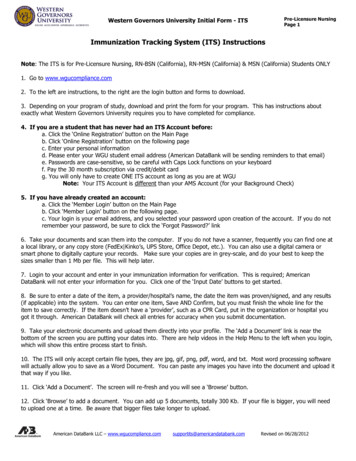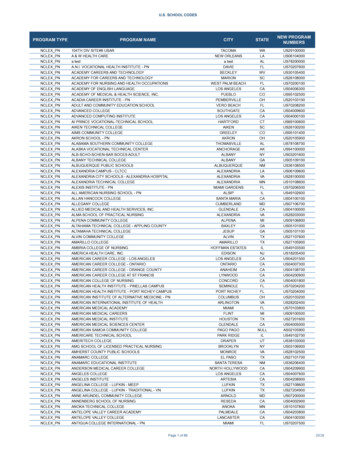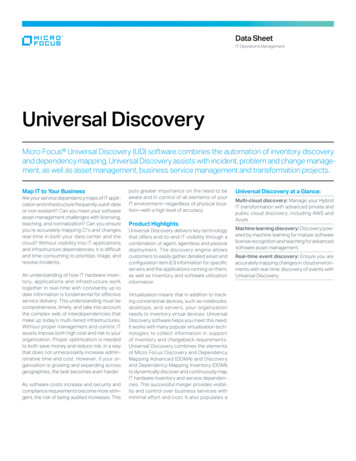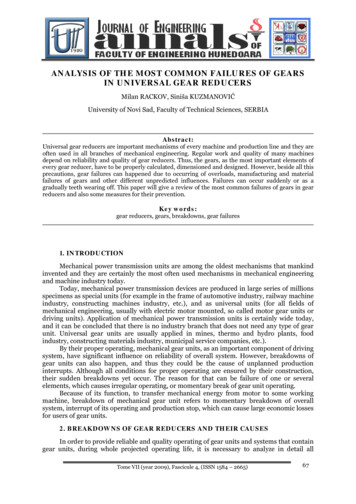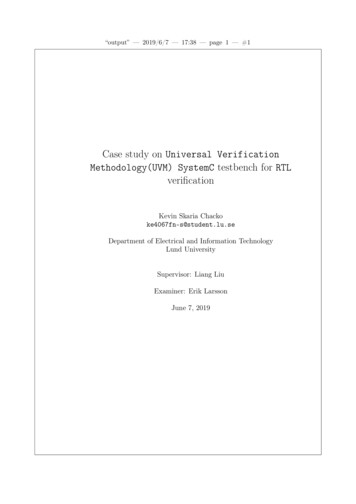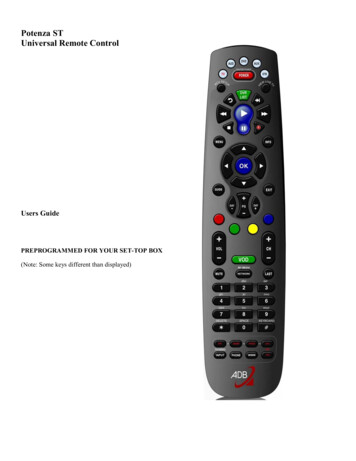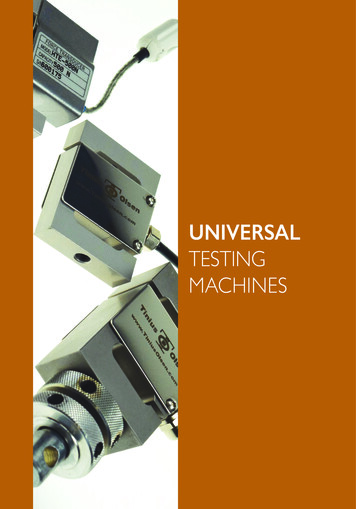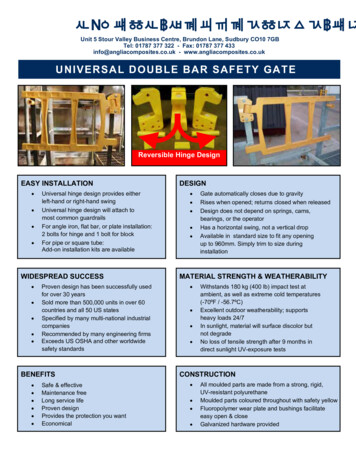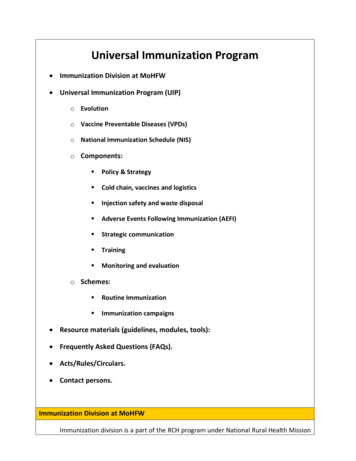
Transcription
Universal Immunization Program Immunization Division at MoHFW Universal Immunization Program (UIP)o Evolutiono Vaccine Preventable Diseases (VPDs)o National Immunization Schedule (NIS)o Components: Policy & Strategy Cold chain, vaccines and logistics Injection safety and waste disposal Adverse Events Following Immunization (AEFI) Strategic communication Training Monitoring and evaluationo Schemes: Routine Immunization Immunization campaigns Resource materials (guidelines, modules, tools): Frequently Asked Questions (FAQs). Acts/Rules/Circulars. Contact persons.Immunization Division at MoHFWImmunization division is a part of the RCH program under National Rural Health Mission
(NRHM) and is placed in the Ministry Of Health and Family Welfare, Nirman BhawanNew Delhi. This division provides all the technical assistance required to undertake theactivities under UIP. The division reviews the state Program implementation plans andfacilitates in its approval process as per norms and guidelines The key roles of thisdivision include activities related to Routine Immunization, Campaigns (SIAs) such asPolio, Measles, and Japanese Encephalitis, Monitoring Adverse Events FollowingImmunization (AEFI), Vaccine and Cold Chain Logistics, Strategic communication relatedto immunization program and trainings related to Immunization Program. It facilitatesthe National Technical Advisory Group on Immunization (NTAGI) to review andrecommend its views on various technical and programmatic issues related toimmunization such as new vaccine introduction etc.The division is engaged inreviewing and sharing the learnings of the program with state and district programofficers. The division also works closely with all development partners and other stakeholders.Organogram of Immunization Division:Universal Immunization Programme (UIP)
Evolution of the programme:1978: Expanded Programme of immunization (EPI). Limited reach - mostly urban1985: Universal Immunization Programme (UIP). For reduction of mortality and morbidity due to 6 VPD’s. Indigenous vaccine production capacity enhanced Cold chain established Phased implementation - all districts covered by 1989-90. Monitoring and evaluation system implemented1986: Technology Mission On Immunization Monitoring under PMO’s 20 point programme Coverage in infants (0 – 12 months) monitored1992: Child Survival and Safe Motherhood (CSSM) Included both UIP and Safe motherhood program1997: Reproductive Child Health (RCH 1)2005: National Rural Health Mission (NRHM)Vaccines under UIP Under UIP, following vaccines are provided:1. BCG (Bacillus Calmette Guerin)2. DPT (Diphtheria, Pertussis and Tetanus Toxoid)3. OPV (Oral Polio Vaccine)4. Measles5. Hepatitis B6. TT (Tetanus Toxoid)7. JE vaccination (in selected high disease burden districts)8. Hib containing Pentavalent vaccine (DPT HepB Hib) (In selected States)Diseases Protected by Vaccination under UIP
1. Diphtheria2. Pertussis.3. Tetanus4. Polio5. Tuberculosis6. Measles7. Hepatitis B8. Japanese Encephalitis ( commonly known as brain fever)9. Meningitis and Pneumonia caused by Haemophilus Influenzae type bVPD surveillance Vaccine Preventable Diseases (VPD) surveillance system is needed to createevidence base to enable planning and deployment of effective interventions. India has different surveillance models. Integrated Disease Surveillance Project(IDSP) is one of those surveillance systems. IDSP is a case-based surveillance system for detection of early warning signals ofoutbreaks. There are other sentinel surveillance systems which falls under differentvertical national health programs for diseases targeted for control, elimination oreradication. Another source is the National Polio Surveillance Project (NPSP), which has doneextremely well in acute flaccid paralysis (AFP) and measles surveillance in India. WHO/NPSP provides needed technical and training support for AFPand measles surveillance.National Immunization Schedule (NIS)
Under UIP, GoI is providing vaccination to prevent seven vaccine preventable diseases, Diphtheria, Pertussis, Tetanus, Polio, Measles, Hepatitis B & Tuberculosis.SNoVaccine& itspresentationProtectionRoute1BCG(Bacillus CalmetteGuerin)Lyophilized vaccineOPV(Oral PolioVaccine)- LiquidvaccineTuberculosis34256Vaccination ScheduleIntra- dermalNumber ofdoses1PoliomyelitisOral5Hepatitis B – LiquidVaccineHepatitis BIntramuscular4DPT (Diphtheria,Pertussis andTetanus Toxoid) –Liquid vaccineMeasles Lyophilized vaccineDiphtheria, IntraPertussismuscularand Tetanus5MeaslesSubcutaneous2Birth dose for institutionaldeliveries, Primary threedoses at 6, 10 & 14 weekand one booster dose at16-24 month of age. GivenorallyBirth dose (within 24 hours)for institutionaldeliveries,Primary three doses at6, 10 & 14 week.Three doses at 6, 10 & 14week and two boosterdose at 16-24 month and5-6 years of age9-12 months of age and2nd dose at 16-24 months.TT (Tetanus Toxoid)– Liquid vaccineTetanusIntramuscular2278JE vaccination(in selected highdisease burdendistricts)Lyophilized vaccineHib (given aspentavalentcontainingJapaneseSubEncephalitis cutaneous(Brain fever)2HibPneumoniaand Hib3Intramuscularat birth (upto 1 year if notgiven earlier)10 years and 16 years ofageFor pregnant woman, twodoses given(one dose ifpreviously vaccinatedwithin 3 Year)9-12 months of age and2nd dose at 16-24 months(6 month after vaccinationdrive)6, 10 & 14 week of age
Hib DPT Hep B) (in8 states) – LiquidvaccinemeningitisIn addition, JE vaccination is provided in 113 districts and additional 62 new JE endemic districtshave been identified. JE second dose has been introduced under UIP in these endemic districts fromApril,13 Pentavalent vaccine introduced in 8 states i.e. Tamil Nadu, Kerala, Haryana, J&K,Gujarat, Karnataka, Goa and Puducherry.Implementation of Routine Immunization RI targets to vaccinate 26 million new born each year with all primary doses and 100million children of 1-5 year age with booster doses of UIP vaccines. In addition, 30million pregnant mothers are targeted for TT vaccination each year. To vaccinate this cohort of 156 million beneficiaries, 9 million immunization sessionsare conducted, majority of these are at village level. As per Coverage Evaluation Survey (2009), 89.8% of vaccination in India is providedthrough Public sector (53% from outreach session held at Anganwadi centre (25.6%),sub centre (18.9%) etc.) while private sector contributed to only 8.7%. ASHA and AWW support ANM by mobilizing eligible children to session site thus try toensure that no child is missed. ASHA is also provided an incentive of Rs. 150/session forthis activity To ensure potent and safe vaccines are delivered to children, a network of 27,000 coldchain points have been created across the country where vaccines are stored atrecommended temperatures.Components:
I. Strategy and policy:National Health Policy (2002) is directed towards achieving an acceptable, affordable andsustainable standard of health through an appropriate health system. Provision of universalimmunization of children against vaccine preventable diseases is one of the major goals underthis policy. Country’s five year plan also puts emphasis on reduction in maternal and infantmortality rates as major maternal and child health indicators. Country developed acomprehensive Multi Year Strategic Plan for Immunization in 2005 with an addendum in 2010to achieve these targets of improving access and utilization of immunization in the country.This document is a national strategy document to guide development of UIP plans at nationaland state levels. Currently development of next multi year plan is under process. Ministry ofHealth and Family Welfare also revised the National Vaccine Policy in 2011. The goal of thisvaccine policy is to guide decision making in order to develop a long term plan to strengthenthe UIP. This policy addresses issues of vaccine security, management, regulation guidelines,vaccine research and development and product development. To ensure informed decisionmaking for any modification in UIP schedule or inclusion of new vaccines, there is a NationalTechnical Advisory Group on Immunization (NTAGI) which comprises of a number of technicalexperts, national program leaders and managers, representatives from development partnersand professional bodies. All issues related to the program and vaccines are presented to thisgroup for review and discussions and final recommendations.II. Cold Chain System, Vaccines and Logistics:Cold Chain is a system of storing and transporting vaccine at the recommendedtemperature range from the point of manufacture to point of use. India has built a vast coldchain infrastructure to ensure that only potent and effective vaccines reach millions ofbeneficiaries across the country. The vaccines are supplied by manufacturers directly to fourGovernment Medical Store Depots (at Karnal, Mumbai, Chennai and Kolkata) and state andregional vaccine stores. The GMSDs supply to the states and regional vaccine stores; state andregional vaccine stores supply vaccines to Divisional vaccine stores and district. The vaccinesare further supplied to last cold chain points which are usually situated in Primary HealthCenters (PHCs) and Community Health Centers. Transportation of vaccines fromStates/Regional stores to divisions and districts is done in cold boxes using insulated vaccine
vans. Vaccines carriers with icepacks are used to transport vaccines from PHCs to the outreachsessions in the village.In addition to the equipment, there are different personnel deployed for cold chain andvaccine handling. In the states, there are State Cold Chain Officers who are in charge to ensuresmooth functioning of all cold chain equipment in the state. At regional, divisional and districtlevels, there are cold chain technicians whose responsibility is to maintain and repair cold chainequipment for maintaining the recommended temperatures for storage of vaccines. At thePHCs and CHCs, cold chain handlers, who are health personnel (pharmacists, male and femalemulti-purpose health workers, etc) have been tasked with proper storage and handling ofvaccines and daily upkeep of Ice Lined Refrigerators (ILRs) and Deep Freezers (DFs) includingtemperature charting. Cold chain technicians have been provided with trainings and tool kitsfor performing installation, maintenance and repair activities. For maintenance of cold chainequipment, Govt. of India provides funds to the state under NRHM.The performance and efficiency of the cold chain system at different levels is monitoredcontinuously, through supervisory visits, review meetings.The Government of India procures and supplies all UIP vaccines along with diluents to allstates. In addition to vaccines, syringes of different capacities, are also procured centrally andsupplied to states. The process involves vaccines and logistics forecasting, scheduling, ensuringsupplies as per need, and so on. It is important to ensure that the cold chain system is not overburdened and there are no under supplies. Supplies are made to states on a quarterly basis onreceipt of indent. State Vaccine Stores can store vaccines for three months and so can districtvaccine stores. PHCs/CHCs send monthly indents to district stores. PHCs can store vaccines fora maximum of one month only.III. Injection safety and waste disposal:A large number of injection procedures are undertaken in lakhs of vaccination sessionsacross the country every year. Unsafe injection practices can harm the recipient of theinjection, the health worker and the community resulting in potentially life threateninginfections such as HIV/AIDS, Hepatitis B and C, etc. To ensure safe injection practices,Government of India endeavours to ensure continuous supply of injection safety equipments
(AD syringes, reconstitution syringes, hub cutters and waste disposal bags). Trainings areconducted and supported by job-aids, on job training (supportive supervision).Disposal of immunization waste is strictly as per Central Pollution Control Board (CPCB)guidelines for biomedical waste disposal. The principles followed are segregation of waste atsource (at the session site), transportation to the PHC or CHC, treatment of sharps andpotentially biohazardous plastic waste, disposal of sharps in sharp pits and treated plasticwaste through proper recycling. The states are provided funds to procure hub cutters, blackand red plastic bags and construction of sharp pits in PHCs and CHCs construction of.IV. AEFI Surveillance System in India:HISTORY 1988: AEFI surveillance started India 2005: National AEFI guidelines developed and disseminated 2007 Onwards: State & District Level AEFI Committees formed 2008: National AEFI Committee constituted. 2010: Guidelines revised, printed and widely circulated. 2011: SOPs printed and disseminated 2012: AEFI Secretariat establishment Over the years: improved trends of reporting. The WHO defines AEFI as “a medical incident that takes place after animmunization, causes concern, and believed to be caused by immunization”. AEFI surveillance in country monitors immunization safety, detects and responds toadverse events following immunization; corrects unsafe immunization practices,reduces the negative impact of the event on health and contributes to the quality ofimmunization activities. Special focus is being provided by Government of India to strengthen the system for
reporting and responding to any Adverse Event Following Immunization (AEFI) Operational Guidelines for AEFI surveillance and response first published in 2005and revised in 2010. These have been disseminated to medical officers all over thecountry An AEFI secretariat has been established under ITSU (Immunization TechnicalSupport Unit) to strengthen &coordinate all issues related to AEFI. India National Regulatory Authority (NRA) assessment has passed successfully in Dec2012. The National AEFI committee has been revised in 201
Limited reach - mostly urban 1985: Universal Immunization Programme (UIP). For reduction of mortality and morbidity due to 6 VPD’s. Indigenous vaccine production capacity enhanced Cold chain established Phased implementation - all districts covered by 1989-90. Monitoring and evaluation system implemented 1986: Technology Mission On Immunization Monitoring under PMO’s 20 point programme .
